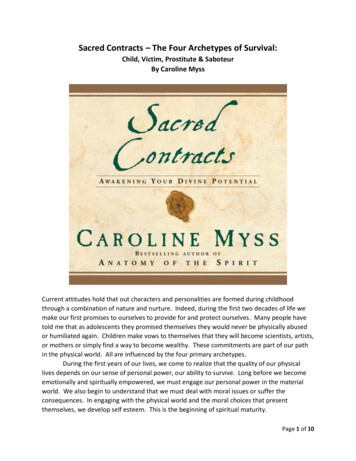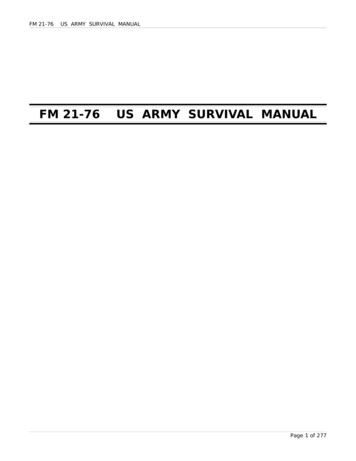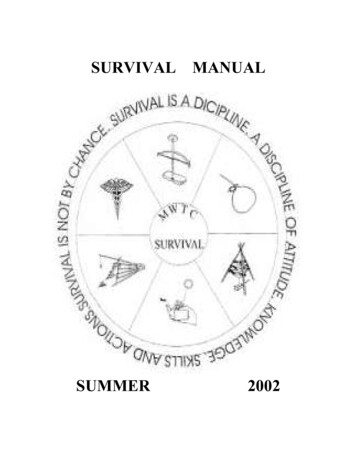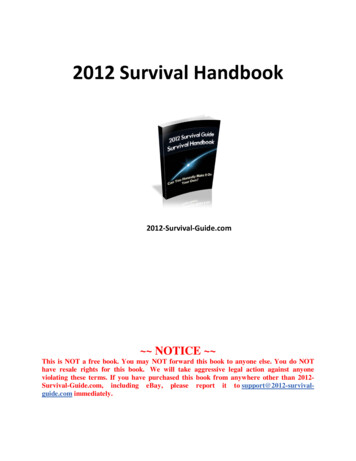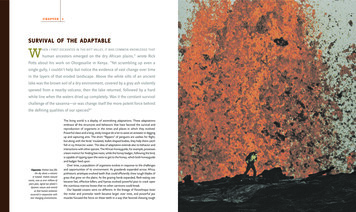
Transcription
c h a pt e r3survival of the adaptableWhen I fIrst excavated In the rIft valley, It was common knowledge thathuman ancestors emerged on the dry african plains,” wrote rickPotts about his work on olorgesailie in kenya. “yet scrambling up even asingle gully, I couldn’t help but notice the evidence of vast change over timein the layers of that eroded landscape. above the white silts of an ancientlake was the brown soil of a dry environment, covered by a gray ash violentlyspewed from a nearby volcano; then the lake returned, followed by a hardwhite line when the waters dried up completely. was it the constant survivalchallenge of the savanna—or was change itself the more potent force behindthe defining qualities of our species?”Opposite: Molten lava fillsthe sky above a volcanoin Iceland. Violent naturalevents, now as over millions ofyears past, signal our planet’sdynamic nature and remindus that human evolutionoccurred in conjunction withever changing environments.The living world is a display of astonishing adaptations. These adaptationsembrace all the structures and behaviors that have favored the survival andreproduction of organisms in the times and places in which they evolved.Powerful claws and a long, sticky tongue do a lot to assist an anteater in diggingup and capturing ants. The short “flippers” of penguins are useless for flight,but along with the birds’ insulated, bullet-shaped bodies, they help them catchfish in icy Antarctic water. The idea of adaptation extends also to behavior andinteractions with other species. The African honeyguide, for example, possessesa keen instinct for finding bee nests; while the honey badger, following the bird,is capable of ripping open the nests to get to the honey, which both honeyguideand badger feed upon.Over time, a population of organisms evolves in response to the challengesand opportunities of its environment. As grasslands expanded across Africa,prehistoric antelopes evolved teeth that could efficiently chew tough blades ofgrass that grew on the plains. As the grazing herds expanded, flesh-eating catsbecame fast, effective killers, and hyenas evolved powerful jaws to crack openthe nutritious marrow bones that no other carnivore could break.Our bipedal cousins were no different. In the lineage of Paranthropus boiseithe molar and premolar teeth became larger over time, and powerful jawmuscles focused the force on these teeth in a way that favored chewing tough
46A Nile crocodile attacks a wildebeestcrossing a river in Kenya. Our ancestorswere vulnerable to many of the samedangers as other creatures were. WHAT DOES IT MEAN TO BE HUMAN?and abrasive foods. Considerably later, the short extremities and broad bodiesof Homo neanderthalensis helped conserve heat and served as adaptations to thecold conditions of Europe in which this species initially evolved.One of the basic principles of biology, therefore, is that adaptations emerge asorganisms face the ongoing tests of survival in their surroundings—finding food,avoiding predators, attracting mates, warding off the cold, and locating shelter.ADAPTIVE CHALLENGESOur species, Homo sapiens, is recent on the evolutionary scene, having firstappeared only about 200,000 years ago. Although all earlier hominins are nowextinct, many of their adaptations for survival—an appetite for a varied diet,making tools to gather food, caring for each other, and using fire for heat andcooking—make up the foundation of our modern survival mechanisms and areamong the defining characteristics of our species.Life was not easy for our ancestors. Without claws or canines, the earliesthominins were physically more or less defenseless. Like other primates, theycould probably toss rocks, wave sticks, and create a big fuss when threatened.They probably slept in trees at night or, at a minimum, huddled together ingroups on the ground.Being Human, Becoming Human: Survival of the AdaptableThe hunting and scavenging efforts of later hominins, including the first tomake stone tools, brought them close to animals that could injure them. Theywere meals for crocodiles and hyenas, as well as for big cats. Flash floods, volcanic eruptions, droughts, and other natural disasters added to their tribulations.Early humans ultimately developed ways to cope with such dangers, butpredators and scavengers always lurked. The lower jaws and limb bones of ancestors who lived between 4.4 million and 3 million years ago are often marred bythe gnawing of dangerous carnivores. At the later site of Olorgesailie, wherehandaxes were left behind by the thousands, no early human remains came tolight despite decades of searching. Then researchers were struck by the possibility that early humans at this site may have found safety in the highlands atnight, when predators typically prowl near water holes. Acting on this hunch,the research team began to dig in the upper margins of the lowlands, andright away found a fossil human cranium that was 900,000 years old. Theonly pieces that remained were bits of the braincase and the brow ridge,which bore puncture marks from the teeth of a carnivore. This early humannever made it home.Fossil human remains evince clues to other dangers, including illness. Oneexample is a Homo erectus adult female whose skeletal remains, found at EastTurkana, Kenya, were covered in a layer of abnormal bone. Researchersdiagnosed a painful condition in which her bones essentially bled, causedby a disease associated with an overdose of vitamin A. How could this havehappened? It turns out that the livers of carnivorous animals concentratethis vitamin at a level extremely toxic to humans, who fall victim to thisterrible condition when the liver of a predator is accidentally consumed.Eating meat and even killing carnivore competitors were survival strategies of our ancestors, but in this case, a small mistake proved deadly.Without medicine, even minor infirmities could be fatal. The robustappearance of the Kabwe cranium from Zambia belies the possibilitythat this Homo heidelbergensis individual died from a small but fatal infection.This individual is one of the oldest known to have had tooth cavities, includingten that invaded the upper teeth. A small perforation in the temporal bone ofthe skull leads to a larger pit on the interior and shows that either dental diseaseor a chronic ear infection was the cause of death.What about fossil evidence of murder or even warfare? Wooden spears about400,000 years old are preserved, and stone spheroids that could have beenthrown date back nearly 2 million years. However, there is no evidence thatmultiple hominins ever died at the sites where they have been found. The earliestknown death from a sharp stone point occurred in one of several Neanderthalindividuals buried during thousands of years in the Shanidar Cave of northernIraq, dated between about 45,000 and 35,000 years old. A severe wound to oneof this individual’s ribs resulted from a forceful thrust of a stone tip from the leftside. Before this, there is no sign of intentional injury in the fossil record. Multiple 47Bite marksBite marks similar in shape to those madeby the teeth of living crocodiles remain in theankle bone of a partial foot, suggesting thefate of a 1.8-million-year-old Homo habilis.
48 WHAT DOES IT MEAN TO BE HUMAN?Being Human, Becoming Human: Survival of the Adaptabledeaths in one place as the result of warfare occurred only more recently and areassociated exclusively with our own species.APPROACHES TO SURVIVALEarth’s Changing Climateand Human EvolutionEarth’s climate has fluctuated betweenwarm and cool over the past ten millionyears. The ratio of two oxygen isotopes, asmeasured in cores drilled from the oceanbottom, ranges from about 2.5 to 5.0 partsper million. This measure reflects both worldwide ocean temperature and the amount ofglacial ice. Particularly dramatic fluctuationsmarked the six-million-year periodof human evolution.With all the signs of injury, disease, and death, one might wonder how our earlyancestors survived at all. But this gives the wrong picture. Although early homininsmay have been relatively defenseless from a physical standpoint, part of theirprimate heritage included impressive defenses against predators, including beingsocial and vocal. Primates in social groups keep watch over each other. Together,they can stay aware of predators and may gang up to scare them away. Many primates have warning calls as well; some are specific to attacks from birds, snakes,and leopards. Social and vocal behaviors like these may have made it reasonablysafe for our ancestors to venture away from the trees in the first place.Throwing stones and using weapons were important additions to self- andgroup defense. There is also clear evidence that by about 800,000 years agosome hominins had controlled fire and built well-defined hearths. Most animalshave an innate fear of fire and would be likely to have kept their distance froma campfire. The light from the campfire would also have helped our ancestorsavoid surprise attacks. Between 800,000 and 400,000 years ago, when we seestrong evidence for building both shelters and hearths, the level of human socialcooperation had reached a crucial milestone.Plant and animaldomesticationBy 10,500years agoMaking tools andeating meat fromlarge animalsWarmerWalking uprighton short legsOxygen isotopes from ocean coresCoolerBy 2.6 millionyears agoLonger childhoodand adolescenceBy 500,000-160,000years agoBy 6 million years ago5.54.53.5Rapid increasein brain size2.5By 500,000years agoPASTT O D AY10 millionyears ago8 millionyears ago6 millionyears ago4 millionyears ago2 millionyears ago 49Possibly the ultimate evidence that social support had become an essentialpart of the human survival package is purposeful burial. Instead of leaving thedead where they lay, Neanderthals and modern humans buried their dead. Itcould be argued that this was simply a sanitary measure, but there is evidencethat suggests far more was going on. We can see this at Shanidar Cave, wherean adult male Neanderthal was carefully placed on his side in a shallow gravein a fetal position. There is good evidence that colorful flowers and evergreenboughs were intentionally placed in the burial with him.Since the physical remains of the deceased do not benefit from burial goodsor rituals, did mortuary practices develop mainly as an advantage to the living?The significance of the earliest burials, at least 100,000 years ago, may be twofold.First, rituals reinforce social bonds and may have helped earlier human groupscope with life’s difficulties by allowing grieving. Second, burials show that humanswere able to conceive of something other than the immediacy and harsh realitiesof their daily lives. Perhaps they imagined an afterlife for their departed lovedones. Or perhaps a better future for themselves.ADAPTATIONS AND ADAPTABILITYThe causes of death offer clues to the events of natural selection that helpedshape our human ancestors’ adaptations. But there was another, equally pervasive influence on evolution—the uncertainties of climate change. While predationand disease exerted an ever present risk, uncertainties in the supply of food andother necessities also posed an incessant challenge to survival.What happened as early humans tried to adjust to weather variations from oneseason to another or to wider swings in rainfall and temperature over time? Andwhat about the misfortunes visited upon them by monsoons, intense droughts,or massive volcanic eruptions?A species depends not only on the particular way of life that best matches itssurroundings but also on keeping certain options open and adjusting to whatevertrials or opportunities occur as things change. The process of evolution not onlyshapes adaptations to specific habitats but also shapes ways of life that confer acertain degree of adaptability. Since individual species may persist for hundredsof thousands, sometimes millions, of years, the capacity to adjust to novel situations is an important outcome of evolution, offering resilience and an ability torecover from difficult times.This idea of adaptability has now become a pillar in the understanding ofhuman origins. One reason is that our own species, Homo sapiens, may well bethe most adaptable mammalian species ever to evolve on Earth. Just look at allthe places on the planet where humans live today, at our capacity to alter oursurroundings to suit our tastes, and at our propensity to seek out completelynovel and challenging places to visit, even outer space.Scientific research shows now that the period of human evolution has beenone of the most volatile eras of environmental change in our planet’s history.A dried-up Texas lake bed may resemblethe remnants of African Rift Valley lakesthat disappeared during prolonged droughts.
50 WHAT DOES IT MEAN TO BE HUMAN?Evidence of vast swings between wet and dry, and between warm and cold, castsour own survival story in a new light.ERRATIC ENVIRONMENTHow do we know aboutclimate history?Researchers have many differentmethods to interpret Earth’s climate history.Drilling sediment layers from lakeand ocean floors produces long cylinders called cores. Drill cores are alsocollected from the thick ice layers ofglaciers and ice sheets. The depths(or lengths) of cores correspond totime, with the most recent layers nearthe top. By studying trapped gas, pollen, charcoal, and microorganismsdeposited in each layer, scientists caninfer changes in past climate.Tree rings and coral are proxies forclimate because their periodic growthrates are affected by environmentalconditions.Cave formations provide usefulinformation because they accumulate more or less rapidly in relationto how wet or arid, respectively, theenvironment is.Fossil plants and animals are usedto reconstruct ancient environmentsand climates. Fossilized leaves, seeds,bark, roots, and pollen are also directindicators of ancient climate. Drawingupon the habitat preferences of livinganimals may help us use animal fossils to infer past habitats.Some time ago, any question concerning the environment in which humansevolved seemed entirely resolved: Early humans were adapted to the Africansavanna. Walking upright on two legs and making implements were criticalto the survival of ancestors who ventured onto the dry, dangerous plains. Asgrasslands spread, hunting and eating meat proved advantageous. The controlof fire staved off predators. With the expansion of early humans into Asia andEurope, the challenges of the Ice Age helped hone the capacity for social cooperation. Speaking to one another helped pass on the traditions of toolmaking.Eventually, language allowed technological innovations to catch on and creativeendeavors, including art, to blossom. All the way back to the earliest bipedalpredecessors, one survival skill led to another, which spurred on still neweradaptations—all against the backdrop of the arid equatorial savanna and thefrigid northern landscape.This notion of a straight line trending toward a drier, colder climate has nowbeen replaced, however, by evidence that past climate fluctuation looked morelike a rambunctious zigzag. The survival conditions of human evolution werecontinually revised as climate oscillated between arid and moist and betweencold and warm. Scientists now speak of the environments of human evolution,with emphasis on variability. And they consider the instability of environments,not merely the expansion of grasslands or glaciers, as having shaped the evolvedcharacteristics of human beings.This relatively new theme in the story of human origins is still a matter ofhypothesis—an overall explanation that is tested again and again as new detailscome to light. One of the exciting challenges in the field of paleoanthropologyis to better understand how our own ancestors may have evolved adaptationsto change—to what researchers call environmental dynamics—rather than to anysingle setting or environmental trend.Evidence about past climates is, naturally, an inspiration for this environmental variability hypothesis. An important record of global climate changecomes from oxygen measurements in ocean microorganisms called foraminifera. Forams, as they are also known, use oxygen in their immediate surroundings to build their tiny calcareous skeletons. As the planet has cooled andwarmed, the levels of different forms, or isotopes, of oxygen have changed.Because the lighter isotope more easily evaporates than the heavier one, itwas extracted from the oceans and incorporated into the expanding ice sheetson land. When these glaciers melted, the water composed of lighter oxygenflowed back into the ocean. Oxygen measurements of the forams obtainedfrom the deep-ocean floor document these fluctuations in Earth’s temperature and ice volume over time.Being Human, Becoming Human: Survival of the AdaptableWhen we look at the oxygen climate curve all the way back to 70 millionyears ago, we see that Earth has indeed cooled dramatically, especially over thepast several million years. Important details come into focus when one examinesthe past ten million years. This shorter record, which includes the era of humanevolution, shows that the cooling actually involved sharp fluctuations betweenwarm and cool. The oscillations began to pick up around six million years ago,near the time the earliest human ancestors originated. The genus Homo evolvedlater, during a time of even greater climate fluctuation. And the immediate predecessors of our own species, Homo sapiens, evolved as climate instability maxedout with the widest oscillations.An equally compelling climate record focuses on the moist-arid fluctuationsin Africa. Cores drilled from the bottom of the Mediterranean Sea give us a longarchive of black mud layers that alternate with lighter bands of silt. The twotypes of sediment are derived from the Nile River. The dark layers are evidenceof strong monsoons that washed black mud, rich with organic material, fromthe huge Nile watershed into the Mediterranean, while the light bands indicate 51Sediments at Olorgesailie, in Kenya,contain a wealth of information aboutclimate change over the past 1.2 millionyears. White and beige sediments reflectthe area’s alternation between a largelake and dry land, respectively. Brownsediments represent deposits of a riverthat flowed through valleys eroded intothe older lake beds.
52 WHAT DOES IT MEAN TO BE HUMAN?Being Human, Becoming Human: Survival of the Adaptable 53Left humerusRight humerusHomo neanderthalensis, Shanidar 1About 45,000 to 35,000 years oldThis Neanderthal survived a crushing blowto the left side of his head and hada withered right arm (left).Australopithecus africanus,Taung ChildAbout 2.8 million years oldA large bird of prey, probablyan eagle, carried this child away.arid times when rainfall declined and vegetation shrank. The recordfrom the past five million years shows that early human speciesexperienced periods of relatively stable climate interruptedby even longer periods when strong shifts between arid andmoist conditions took place. Each interval lasted from afew thousand to several hundreds of thousands of years.This long-term switching back and forth between highand low climate variability had a persistent influenceon the survival and ways of life of early humans as theyevolved in Africa.Environmental records from all over the world confirm the magnitude of climate fluctuation. The longestenvironmental archive from any continent comes from theLoess Plateau of central China, a 400,000-square-kilometer(150,000-square-mile) region that has accumulated windblowndust over the past 21.5 million years. There, researchers have documented continuous shifting between arid periods, when loess blew infrom the northern deserts, and moist times when rich vegetation converted theloess into soil. Each of these phases lasted as long as tens of thousands of years.Although the fluctuations have occurred over many millions of years, they wereespecially large during the past 2.6 million years, around the same time as theglacial cycles of the Northern Hemisphere began.Because instability in weather, food, and water inevitably posed challengesto survival, climate variability may ultimately help us make sense of the demiseof species in our own family tree. Usually it’s very difficult to pinpoint a singlecause of extinction for any fossil species. Yet the habits of the large-toothedParanthropus boisei, which lasted in Africa for a million years, or of the coldadapted Homo neanderthalensis, which thrived in Eurasia for 200,000, wererepeatedly tested as favored habitats expanded and contracted, sometimes moreseverely than others. Climate fluctuation also meant variation in the parasites,predators, and other dangers that challenged human ancestors where theylived. Over the past three million years in particular, powerful climate swingswould have led to large fluctuations in supplies of crucial resources, contributingto occasional crashes in population size. All of these factors can influence thesurvival or extinction of species.This leads to a curious finding in the studyof human origins: Our closest evolutionarycousins—species that also walked upright, madetools, and had large brains—went extinct, eventhough these basic characteristics were at onetime considered to be the hallmarks of evolutionary success in human beings. This findingbrings us back to the question of adaptability.Eagle talon marksCLIMATE CHANGE AND EVOLUTIONThe rapidly expanding data on past climate change have started to recast our ideasabout the evolution of human adaptations. What benefits did those adaptationsoffer as our ancestors confronted shifting conditions? The advent of uprightwalking, for instance, did not mean that our oldest ancestors abandoned thetrees entirely. Instead, they walked across open terrain and climbed trees in morewooded areas. But later, as African environments varied dramatically betweenmoist and dry, the ability to walk long distances would pay off well in the diverselandscapes encountered by Homo erectus. Similarly, at the dawn of stone technology, the basic toolkit—including hammerstones that could crush as forcefully as anelephant’s molar and sharp-edged flakes that could cut as finely as a carnivore’stooth—would enable the earliest toolmakers of the genus Homo and possiblylate Australopithecus to eat new kinds of food as conditions changed. Later still,as conditions continued to change, our evolving brain began to deal with richerand more complex surroundings and social interactions. Any improvement inhow quickly brains could process information, call up memories, and forge newthoughts could have made the difference between survival and extinction.One of the most impressive and unusual aspects ofhumans today is the way in which we alter our surroundings. Creating stone implements, controlling fire, building shelters, growing and storing food: All represent waysof altering the immediate surroundings. Each made life abit more predictable, furthering survival in surroundingsthat were prone to change. The entire package provedso successful that, eventually, the sole surviving hominin—Homo sapiens—was able to spread around the globe.Certain abilities that evolved in earlier human species proved especially beneficial in times of change. Whether or not this variability hypothesis of humanevolution stands up to all the tests of scientific data down the road, the drama ofenvironmental change is now understood as a prominent backdrop to the storyof our origins. In the end, it may offer new insights into the origin and currentstatus of our own species.Homo heidelbergensis,Kabwe 1, “Rhodesian Man”About 300,000 to 125,000 years oldThis Homo heidelbergensis lived withsevere cavities (left) and perhaps diedfrom a bone infection.FAQ:How does evolution occur?Genetic variation is fundamental to evolution. A population’s gene pool undergoes slight changes every generation because of mutation and the recombining of parents’ DNAin their offspring.To survive, living things adapt to their surroundings. Naturalselection provides an important mechanism for change in apopulation’s gene pool over time. A genetic variation occasionallygives a member of a species an edge. That individual passes thebeneficial gene on to his or her descendants. More individuals withthe new trait survive and pass it on to their descendants. If manybeneficial traits arise over time, a new species—better equipped tomeet the challenges of its environment—can evolve.
Homo sapiens, may well be the most adaptable mammalian species ever to evolve on Earth. Just look at all the places on the planet where humans live today, at our capacity to alter our surroundings to suit our tastes, and at our propensity to seek out completely



